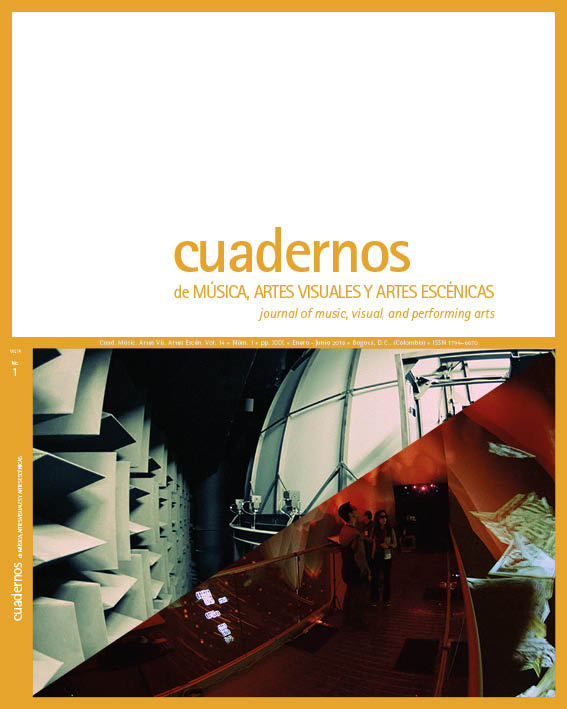Abstract
The purpose of this article is to expose the space as one of the main artistic concerns in the sound installation from different points of view (artistic, aesthetic and philosophical). The spatial thought of the philosophical work Esferas, by Peter Sloterdijk, is taken as a basis for reflection, whose fundamental proposal is that life is a question of form, that any space imagined and created by humanity manifests a way of doing and being, and it is in that place where the essence of mankind can be understood. The works of diverse artists, whose work has been developed to a large extent in the form of this practice, are analyzed in order to treat the experience of space from the sound creation. Among them are Max Neuhaus, Robin Minard and Céleste Boursier-Mougenot. Finally, a connection is interwoven between the works analyzed and various qualities of Sloterdijk’s spatial thinking to expose them as spaces of creation that reveal a way of relating to the environment through what is heard. What is heard and how it is shared are innate questions to the experimentation of this artistic form, hence the importance of the immersion, the listening, the journey. From this point of view, the analyzed works are understood as territories that interrogate artistic and aesthetic listening, an activity with a dynamism that transforms, interrogates and redeems the spaces of life.
Distributed Art Pub Inc.
Boursier-Mougenot, Céleste. 2002. “Entrevista con Camille Labro”. Magazin Beaux-arts (213): 54.
— 2008. États seconds. Arlès: Analogues.
Foucault, Michel. 2009. Le corps utopique, les hétérotopies. París: Nouvelles Éditions Lignes.
Kihm, Christophe. 2008. “Ajustements: entretien de Christophe Kihm avec François Quintin”. En États
seconds, de Céleste Boursier-Mougenot, 22-75. Arles: Analogues.
“Klangstille”. 1995. “Klangstille” (sala de lectura de la Universidad Técnica de Berlín TU). 1995. Niko
Catania. http://www.robinminard.com/minard.content.php?id=40&sh=0Minard, Robin. 1996. Sound
Installation Art. Graz: Editeur Institut für Elektronische Musik.
Neuhaus, Max. 1995. Evoquer l’auditif. Niza: Editorial Charta/Museo de Arte Contemporáneo Villa Arson.
— 1998. “Max Neuhaus from a conversation with Michael Tarantino”. Two Passages. http://www.
maxneuhaus.info/soundworks/vectors/passage/twopassages/
— 1999. “Mysterious Noises on 46th Street | Times Square New York City”. http://adam.curry.com/
art/1376408041_QPUL9BYF.html.
Regnauld, Hervé. 2011. “Le concept de tout est une forme: la pensée spatiale de Peter Sloterdijk”.
EspacesTemps.net. https://www.espacestemps.net/articles/le-concept-de-tout-est-une-forme-lapensee-
spatiale-de-peter-sloterdijk/
Roberts, Lynda. 2017. “NYC, Listening to Max Neuhaus’s Times Square”. Flickr. https://www.flickr.com/
photos/publicassembly/37410284151
Schulz, Bernd. 2003. “Form and Function in the Sound art of Robin Minard”. En Silent Music: Between
Sound art and Acoustic Design, de Robin Minard. Heidelberg: Kehrer Verlag.
Sloterdijk, Peter. 1987. Critique de la raison cynique. París: Christian Bourgois.
— 2001. Extrañamiento del mundo. Valencia: Pre-Textos.
— 2002. Sphères I, Bulles. París: Hachette.
— 2006. Esferas III. Madrid: Siruela.
Szendy, Peter. 2001. Écoute: une histoire de nos oreilles. París: Minuit.
— 2015. En lo profundo de un oído: una estética de la escucha. Santiago de Chile: Metales Pesados.
Vásquez Rocca, Adolfo. 2008. Peter Sloterdijk: esferas, helada cósmica y políticas de climatización.
Valencia: Institució Alfons el Magnànim/Diputación de Valencia.
Wuillème, Tanguy. 2002. “Peter Szendy, Écoute. Une histoire de nos oreilles, précédé de
Ascoltando par Jean-Luc Nancy“, Questions de communication. http://journals.openedition.org/
questionsdecommunication/6532.
Esta revista científica se encuentra registrada bajo la licencia Creative Commons Reconocimiento 4.0 Internacional. Por lo tanto, esta obra se puede reproducir, distribuir y comunicar públicamente en formato digital, siempre que se reconozca el nombre de los autores y a la Pontificia Universidad Javeriana. Se permite citar, adaptar, transformar, autoarchivar, republicar y crear a partir del material, para cualquier finalidad, siempre que se reconozca adecuadamente la autoría, se proporcione un enlace a la obra original y se indique si se han realizado cambios. La Pontificia Universidad Javeriana no retiene los derechos sobre las obras publicadas y los contenidos son responsabilidad exclusiva de los autores, quienes conservan sus derechos morales, intelectuales, de privacidad y publicidad.
El aval sobre la intervención de la obra (revisión, corrección de estilo, traducción, diagramación) y su posterior divulgación se otorga mediante una licencia de uso y no a través de una cesión de derechos, lo que representa que la revista y la Pontificia Universidad Javeriana se eximen de cualquier responsabilidad que se pueda derivar de una mala práctica ética por parte de los autores. Como consecuencia de la protección brindada por la licencia de uso, la revista puede publicar retractaciones o corregir la información ya publicada. La publicación de contenidos en esta revista no representa regalías para los contribuyentes.



